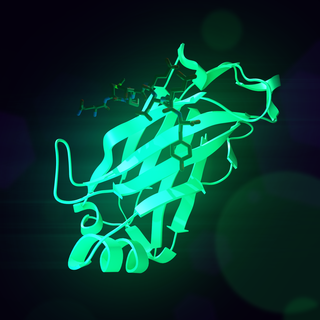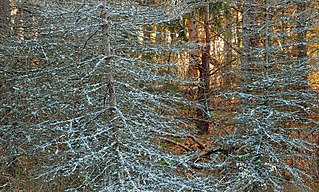
Ascomycota is a phylum of the kingdom Fungi that, together with the Basidiomycota, forms the subkingdom Dikarya. Its members are commonly known as the sac fungi or ascomycetes. It is the largest phylum of Fungi, with over 64,000 species. The defining feature of this fungal group is the "ascus", a microscopic sexual structure in which nonmotile spores, called ascospores, are formed. However, some species of the Ascomycota are asexual, meaning that they do not have a sexual cycle and thus do not form asci or ascospores. Familiar examples of sac fungi include morels, truffles, brewers' and bakers' yeast, dead man's fingers, and cup fungi. The fungal symbionts in the majority of lichens such as Cladonia belong to the Ascomycota.

Penicillium is a genus of ascomycetous fungi that is part of the mycobiome of many species and is of major importance in the natural environment, in food spoilage, and in food and drug production.

Mites are small arachnids. Mites span two large orders of arachnids, the Acariformes and the Parasitiformes, which were historically grouped together in the subclass Acari. However, most recent genetic analyses do not recover the two as each other's closest relative within Arachnida, rendering the group non-monophyletic. Most mites are tiny, less than 1 mm (0.04 in) in length, and have a simple, unsegmented body plan. The small size of most species makes them easily overlooked; some species live in water, many live in soil as decomposers, others live on plants, sometimes creating galls, while others again are predators or parasites. This last type includes the commercially destructive Varroa parasite of honey bees, as well as scabies mites of humans. Most species are harmless to humans, but a few are associated with allergies or may transmit diseases.

The Russulaceae are a diverse family of fungi in the order Russulales, with roughly 1,900 known species and a worldwide distribution. They comprise the brittlegills and the milk-caps, well-known mushroom-forming fungi that include some edible species. These gilled mushrooms are characterised by the brittle flesh of their fruitbodies.
A skin infection is an infection of the skin in humans and other animals, that can also affect the associated soft tissues such as loose connective tissue and mucous membranes. They comprise a category of infections termed skin and skin structure infections (SSSIs), or skin and soft tissue infections (SSTIs), and acute bacterial SSSIs (ABSSSIs). They are distinguished from dermatitis, although skin infections can result in skin inflammation.

Receptor activator of nuclear factor κ B (RANK), also known as TRANCE receptor or TNFRSF11A, is a member of the tumor necrosis factor receptor (TNFR) molecular sub-family. RANK is the receptor for RANK-Ligand (RANKL) and part of the RANK/RANKL/OPG signaling pathway that regulates osteoclast differentiation and activation. It is associated with bone remodeling and repair, immune cell function, lymph node development, thermal regulation, and mammary gland development. Osteoprotegerin (OPG) is a decoy receptor for RANKL, and regulates the stimulation of the RANK signaling pathway by competing for RANKL. The cytoplasmic domain of RANK binds TRAFs 1, 2, 3, 5, and 6 which transmit signals to downstream targets such as NF-κB and JNK.

Mycoviruses, also known as mycophages, are viruses that infect fungi. The majority of mycoviruses have double-stranded RNA (dsRNA) genomes and isometric particles, but approximately 30% have positive-sense, single-stranded RNA (+ssRNA) genomes.

Termitomyces, the termite mushrooms, is a genus of basidiomycete fungi belonging to the family Lyophyllaceae. All of which are completely dependent on fungus-growing termites, the Macrotermitinae, to survive, and vice versa. They are the food source for these termites, who enjoy an obligate symbiosis with the genus similar to that between Atta ants and Attamyces mushrooms. Termitomyces mushrooms are edible, and are highly regarded for their flavor.

The Pleosporales is the largest order in the fungal class Dothideomycetes. By a 2008 estimate, it contained 23 families, 332 genera and more than 4700 species. The majority of species are saprobes on decaying plant material in fresh water, marine, or terrestrial environments, but several species are also associated with living plants as parasites, epiphytes or endophytes. The best studied species cause plant diseases on important agricultural crops e.g. Cochliobolus heterostrophus, causing southern corn leaf blight on maize, Phaeosphaeria nodorum causing glume blotch on wheat and Leptosphaeria maculans causing a stem canker on cabbage crops (Brassica). Some species of Pleosporales occur on animal dung, and a small number occur as lichens and rock-inhabiting fungi.

Forest dieback is a condition in trees or woody plants in which peripheral parts are killed, either by pathogens, parasites or conditions like acid rain, drought, and more. These episodes can have disastrous consequences such as reduced resiliency of the ecosystem, disappearing important symbiotic relationships and thresholds. Some tipping points for major climate change forecast in the next century are directly related to forest diebacks.

High affinity immunoglobulin epsilon receptor subunit beta is a protein that in humans is encoded by the MS4A2 gene.

A fungus is any member of the group of eukaryotic organisms that includes microorganisms such as yeasts and molds, as well as the more familiar mushrooms. These organisms are classified as one of the traditional eukaryotic kingdoms, along with Animalia, Plantae and either Protista or Protozoa and Chromista.

Cytospora is a genus of ascomycete fungi. The genus was first described in 1818 by Christian Gottfried Ehrenberg. Cytospora species are known as plant pathogens.
Coniella is a fungus genus in the family Schizoparmeaceae, which contains 65 species recorded in the database Mycobank. This genus Coniella are reported as a typical plant pathogenic fungi for grape, eucalyptus and several plant. It mainly found in Europe, Asian, also South Africa. less report in American, only one paper published new spaces founded.

Aureobasidium is a genus of fungi belonging to the family Dothioraceae.

Camarosporium is a genus of fungi belonging to the order Pleosporales, and originally placed in family Coniothyriaceae. It was then placed in the family Camarosporiaceae Wanas., Wijayaw., K.D. Hyde & Crous, 2017 with another genus Camarosporomyces. This has been accepted by Wijayawardene et al. 2020.
Lambertella corni-maris is a small ascomycete fungi. It grows in deciduous fruit areas, and causes postharvest Lambertella rot on apple fruits. The species also forms a mycoparasitism relationship with Monilinia fructigena. It is the type species of the genus Lambertella.














